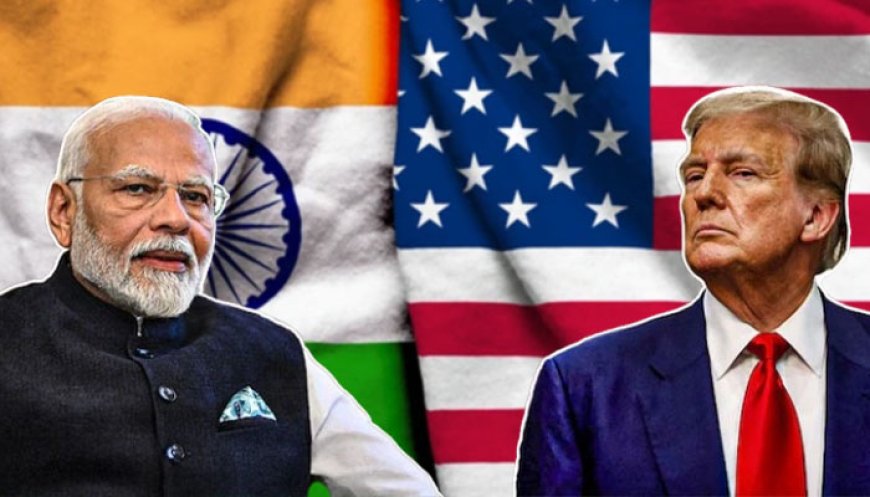Trump Hikes Tariff on India to 50% Over Russian Oil Trade Deal
U.S. President Donald Trump issued an executive order today, slapping an additional 25% tariff on Indian imports, which pushes the total U.S. duty on Indian goods to a staggering 50%.

U.S. President Donald Trump issued an executive order today, slapping an additional 25% tariff on Indian imports, which pushes the total U.S. duty on Indian goods to a staggering 50%. This punitive measure responds to India’s ongoing purchases of discounted Russian oil, which the White House says indirectly helps fund Russia’s war effort in Ukraine
-
Tariff Increase: From 25% to 50%, effective in 21 days (around August 27, 2025), with exemptions for goods already in transit or arriving before September 17
-
Reason Cited: India’s continued direct or indirect imports of Russian oil—seen by Washington as a threat to U.S. national security and foreign policy
-
India’s Response: Deemed the move “selective and unfair,” stressing imports are driven by domestic energy needs, and vowing to protect its national interests
-
Trade Relations at Risk: Analysts warn that the steep duty could discourage exports, particularly in textiles, gems, pharmaceuticals, and the auto sectors, impacting U.S.–India trade dynamics.
According to White House documentation, Trump invoked the International Emergency Economic Powers Act (IEEPA) to bolster tariff authority. The Executive Order emphasizes:
India’s imports of Russian oil undermine U.S. efforts to counter Russia’s destabilizing actions in Ukraine.
The U.S. sees profitable resale of Russian oil by India as indirectly funding Moscow’s aggression
The 50% tariff is intended as both economic pressure and a deterrent, with similar measures potentially applied to other nations if necessary
India’s Ministry of External Affairs decried the tariff hike as “unjustified, unreasonable,” noting that many countries, including the U.S. and EU, continue trading with Russia despite the situation
Emphasized energy security for its 1.4 billion citizens as the overriding priority
India remains firm on its energy policy, despite U.S. retaliation threats. Analysts say Modi's administration may consider alternative economic concessions, but a direct rollback on Russian oil imports looks unlikely
The sudden tariff escalation reflects collapsed trade talks—despite five negotiation rounds, India anticipated a tariff cap of around 15% but has now faced a 50% spike
For India:
-
Export Shock: A doubling of tariff burdens threatens competitiveness across export-heavy sectors like textiles, footwear, jewelry, pharmaceuticals, and automobiles.
-
Trade Losses: Industry bodies warn that a large share of Indian exports—up to 50%—may be derailed
For the U.S.:
-
Higher Prices: Consumers and businesses may face inflationary pressures due to costlier imports.
-
Political Impact: Trump's aggressive tariff strategy aligns with domestic priorities—protecting American jobs and reducing trade deficits, though critics warn of trade disruption.
Global Ripples:
-
Russia’s Economy: U.S. sanctions and secondary tariffs are squeezing Moscow's oil earnings, contributing to fiscal strain
-
Energy Markets: Any disruption in India's oil sourcing or shifts in global demand dynamics could jolt global energy markets
-
Negotiation Opportunity: The 21-day delay before the tariff takes effect may open pathways for India–U.S. talks, particularly if adjustments are negotiated
-
Wider Policy Reach: Trump signaled that other countries buying Russian oil—like China—could face similar penalties. U.S. officials are assessing additional “secondary tariffs”
-
Enhanced Tensions: The tariff move deepens friction between Washington and New Delhi, threatening the relatively promising rapprochement seen earlier in 2025
President Trump’s decision to double tariffs on Indian imports to 50% underscores a bold fusion of trade policy and geopolitical strategy. While Washington frames it as a necessary measure to weaken Russia’s war capability, India sees it as a punitive overreach that unfairly targets its economic sovereignty. Amid mounting tensions, the world watches whether diplomacy prevails—or if trade relations descend further into disarray.

 ateeq.r
ateeq.r